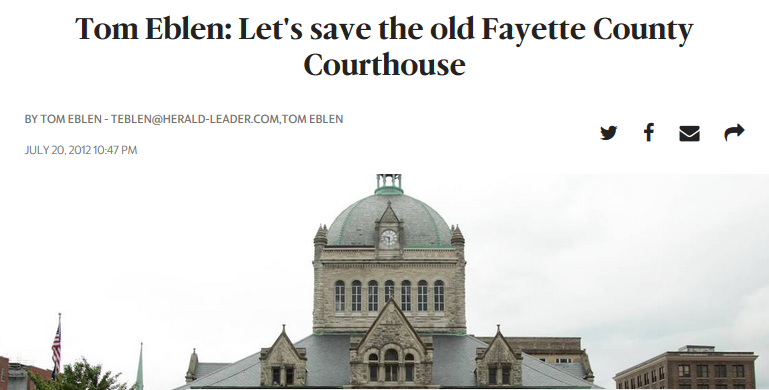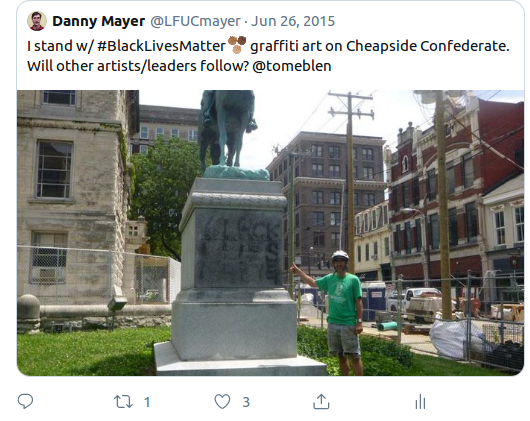2012: The Oracle speaks
If you want to mark the moment when the old Fayette County courthouse began its transformation from condemned property to county jewel, when that momentum of decay, neglect and abandonment had petered out, the forces of civic slumlordism officially ceding their momentum to those of revitalization and renovation, one could do worse than July 20, 2012, the day Lexington Herald Leader journalist Tom Eblen published his column, “Let’s Save the old Fayette County Courthouse.”

A week earlier, the city had condemned the building due to dangerous levels of asbestos, mold, and lead paint. Also, the roof leaked, and the heating and air conditioning no longer worked.
Eblen’s article highlighted what would become the prevailing history of how the courthouse fell into such disarray:
Designed and built in 1898 to be “Lexington’s pride and joy,” an iconic “Richardsonian Romanesque temple that dominated the center of downtown.” Two renovations in the 1960s and 70s, made necessary by Fayette’s post World War II growth, that aesthetically ruined both pride and joy by employing drop-down ceilings (for energy efficiency and additional space) and filling in the grand central rotunda with elevators (ADA compliance) and restrooms (modern sewage).
Then, a move to a new courthouse in 2001 that left the building vacant. The plan to renovate it into an art and history museum, foiled by 9/11 and economic recession. The ensuing decade of disinvestment in which a series of museums–the Lexington Public Safety Museum, the Isaac Scott Hathaway Museum, the Lexington History Museum, the Kentucky Renaissance Pharmacy Museum–came and went.
Eblen’s article was also notable for its incisive peek into the courthouse’s revitalized and buzzword-y future: our pride and joy would be “re-imagined” with “a bigger purpose.” Also, a business plan! The final ten paragraphs sketched out the Eblen Proposal, a sort of cocktail-napkin rendering of what the courthouse renovation project would become six years later.
“I see the old courthouse as Lexington’s visitors center—and more,” Eblen dreamed in July 2012. The Proposal elaborated: more meant renting out upstairs space for offices, and some of the first floor to a restaurant “with outdoor dining on the surrounding terrace” as a foodie complement for “one of Lexington’s hottest restaurant districts.” More meant less space for a “more-focused” “museum of museums,” to be managed by the Lexington History Museum.

The Eblen Business Plan would rely upon new market and historic preservation tax credits to offset renovation costs. Such credits would require that the city set up a limited-liability corporation “to manage the city-owned building” and collect rent payments to “go toward utilities and maintenance.” In this way, the Eblen LLC would perform a civic duty—upkeep!—that the government had proven ill equipped to perform.
As a forward-looking document of what the renovated courthouse would become, six years later, the Eblen Proposal of July 2012 was uncanny in its predictions. Our community Oracle nailed the business plan, the LLC (actually an LLLP), the New Market Tax credits, and the privatized maintenance scheme. There would indeed be a restaurant on the terrace—and a bar, too, owned by the same celebrity chef—and a visitor’s center with office spaces above it.
There would be misses, of course. Not even Nostradamus was perfect. The Oracle missed, completely, the long-simmering debate that would go public in 2015 over the two Confederate monuments that had stood, well maintained by our civic leaders, in front of the old Courthouse for over a century. The history museums had to go, obviously. And even Eblen could not have predicted the radical re-imagination of the third floor as an event space for the jet set.

As a whole, though, quite remarkable. Over the next half-decade, politicians, journalists, editorial boards, and social media hype would all cohere around the same notable aesthetic dates—iconic 1898 construction; 60’s and 70’s crappy renovation, slow descent into 2012 condemnation. In addition to this aesthetic history, the Eblen Proposal would also come to define city deliberations: how to revive the old public courthouse to its former aesthetic glory—open dome, horse weather-vane and all—while also transitioning the building into its inevitable privatized, tourist-focused future.
Oracles—the good ones, at least, those who we still consider—also tend to capture unknowing detritus, bits of historicity that seep into their grand proclamations of the past and intuitions of the future. In Eblen’s case, these bits come in the form of past and present cost analyses.
From that iconic 2012 article, the Oracle speaks about the city’s proposed, never-enacted, 2001 courthouse renovation:
[T]here were dreams of converting the old building into a $22 million art and history museum, complete with underground galleries with skylights. That effort fell apart after the 9/11 terrorist attacks and the economic slump that followed.
And here is the Oracle, same article, delivering the estimate for what the city would come to build build five years later:
The bad news is that a complete renovation would cost about $15 million.
Presumably, Eblen described this number as “bad news” because our man with a business plan found $15 million a high price to pay in 2012.
Of course, in hindsight, which is better than an Oracle’s fever dreams, this $15 million figure now seems like a bargain. In achieving nearly all of the desired outcomes of the Eblen proposal, the city ended up spending $32 million on the New Old Courthouse, something that neither the Oracle nor all those entities following Him ever bothered to take notice of.




student
The courthouse has definitely came a long way !!!! NEED MORE PICS!!!!!!
Danny Mayer
In the research I have come across, the Chevy Chaser’s “Historic Justice” article (12/19/2018) contains some of the best images of the renovated courthouse. Check ’em out:
https://smileypete.com/community/historic-justice/